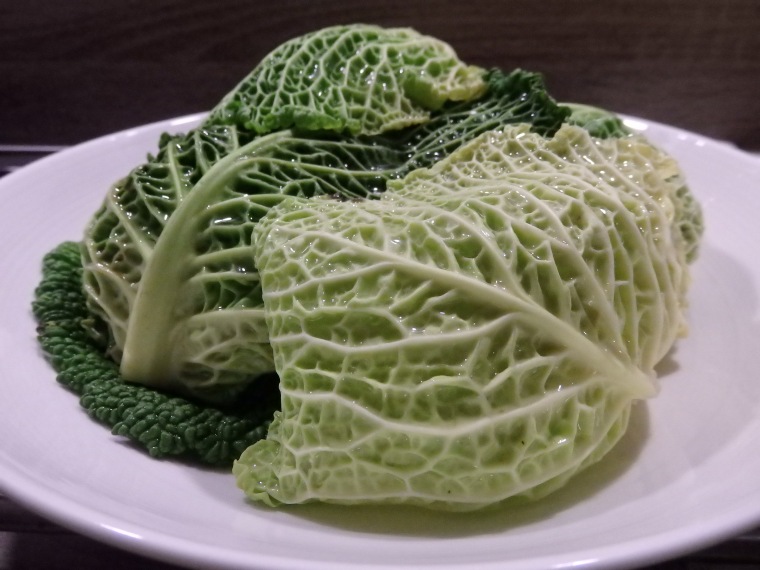 We’ve been eating a lot of cabbage around here lately, and I think it’s time to tell you a bit about it.
We’ve been eating a lot of cabbage around here lately, and I think it’s time to tell you a bit about it.
I imagine there’s a divide among you about this very affordable, sometimes beautiful and often times under appreciated vegetable. You probably know already whether you love cabbage or not, and I suspect that if you’re in the latter group, you’re not looking to be persuaded. So this post is more of a showcase and offering of what we’ve been doing lately.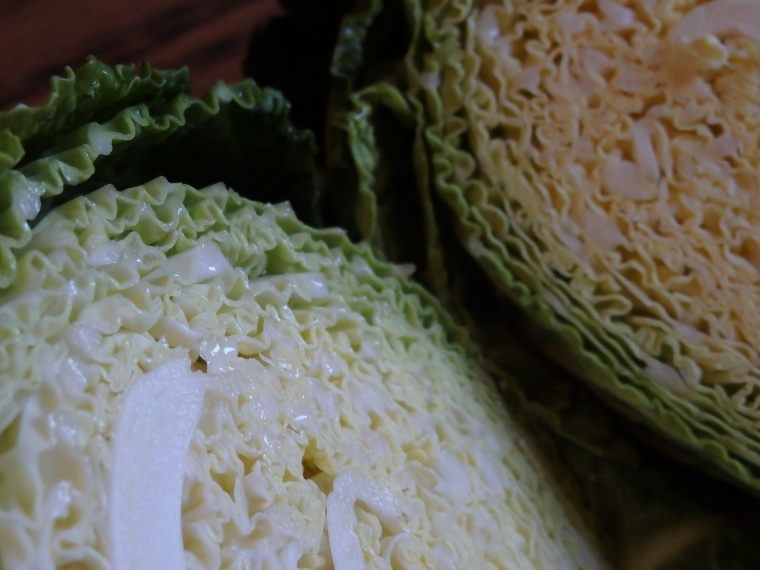 I have the good fortune of having a relatively neutral stance towards this divisive vegetable. I was spared the childhood nightmare of suffering over a plate of boiled cabbage while an adult (parents, yes, but these stories seem to have more to do with terrible school meals) demanded I finish the overcooked mush. I can see how such experiences would ruin its chances. Fortunately for me, I simply don’t remember eating it as a child. I don’t know if it’s because I disliked cabbage so much, or that perhaps my mother did, or maybe it just didn’t grow well in our garden. Whatever the reason, not having childhood cabbage memories is almost certainly to my advantage.
I have the good fortune of having a relatively neutral stance towards this divisive vegetable. I was spared the childhood nightmare of suffering over a plate of boiled cabbage while an adult (parents, yes, but these stories seem to have more to do with terrible school meals) demanded I finish the overcooked mush. I can see how such experiences would ruin its chances. Fortunately for me, I simply don’t remember eating it as a child. I don’t know if it’s because I disliked cabbage so much, or that perhaps my mother did, or maybe it just didn’t grow well in our garden. Whatever the reason, not having childhood cabbage memories is almost certainly to my advantage.
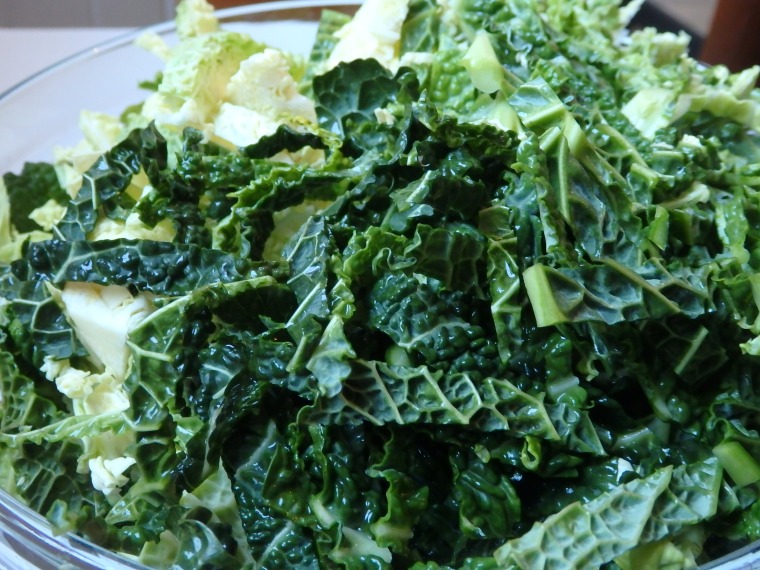 Because by the time I started cooking for myself in Ireland, on a tight budget, I was ready to learn how a whole head could be coaxed it into something glorious, if homely. Don’t get me wrong, savoy cabbages are probably the most beautiful vegetable out there. I don’t think one has passed through our kitchen without being subjected to a photo shoot. But that doesn’t mean their cooked counterparts are nearly as inviting.
Because by the time I started cooking for myself in Ireland, on a tight budget, I was ready to learn how a whole head could be coaxed it into something glorious, if homely. Don’t get me wrong, savoy cabbages are probably the most beautiful vegetable out there. I don’t think one has passed through our kitchen without being subjected to a photo shoot. But that doesn’t mean their cooked counterparts are nearly as inviting.
So let’s get onto how these beauties have made their way into our meals:
This ‘approximately a soup’ by Orangette‘s Molly Wizenberg has been my absolute stand-by for savoy cabbage ever since she posted about it three years ago (she had read about it on Luisa Weiss’ site here, but I’d missed it somehow). Sometimes we loosen it up, sometimes keep it very close to a risotto. Lately, we’ve been doing Marcella Hazan’s smothered cabbage recipe on its own and just keeping it in the fridge to add to any meal along the way – great in a frittata, lovely as a sort-of pasta sauce, perfect in a wrap… you get the idea. If you haven’t brought a savoy to its knees with this recipe yet, please do so now.
With one absolute and versatile star in my pocket, I hadn’t been looking much further. Yes, I have been dabbling in sauerkraut and will tell you more about that soon. (I started another batch this weekend, so we’ll see how that goes. I’m already enamored with it because a) the brine emerged generously, b) the batch all fit in the jar I’d intended to use despite what seemed like an impossible challenge, and c) we grated some beet into this batch, and the color has a blush that makes me hope it’s ready to eat on Valentine’s Day.)
What really tipped it over the edge for me this week, though, was my first attempt at stuffed cabbage leaves. I have been flipping through Mark Bittman’s How to Cook Everything Vegetarian quite a bit lately, and found myself spending an odd amount of time in the stuffed vegetables section.
I think I’ve avoided stuffed cabbage because the images of wilted, translucent leaves with strange meat mixtures have – rightly – been a bit off-putting. Bittman suggests using savoy leaves, which made me pause (see above my love of their beautiful form). Then he suggested, instead of a meat filling, a flavorsome rice and lentil mixture, maybe with a little cheese if you’re taking it in that direction.
Well, that sounded pretty good, even without the cheese. We had just found the absolute BEST way to cook flavorful rice pilafs earlier this week, so I was anxious to see how it worked if we bulked it out with lentils as well. It turns out, it was a huge success.
We don’t have a steamer, but Bittman suggests a red wine braising liquid instead. I was reluctant to invest too much in the sauce in the event that the whole idea was a flop, so it was back to the drawing board. A memory that Deb Perelman had a stuffed cabbage recipe based around a tomato sauce gave me the push to bring this dish to life.
I put together a simple tomato sauce, let that simmer in my widest cast iron pan while I built a version of Bittman’s rice and lentil mixture and prepared the cabbage leaves according to Perelman’s suggestions.
What emerged was a meal I’d be happy to serve to guests or just quietly eat all by myself. A fantastic addition to our savoy cabbage recipes.
I’ve cobbled together a recipe below, but please feel free to adapt as much as you’d like to make this dish to your family’s liking. The important thing is that you give it a try, because it’s worth the effort.
Cabbage Leaves stuffed with Rice and Lentil Pilaf
Adapted from Mark Bittman’s Cabbage Stuffed with Lentils and Rice and Smitten Kitchen‘s Alex’s Mom’s Stuffed Cabbage
Serves 4 as a main course or 6 as a side
Braising sauce
2 Tablespoons butter (or olive oil to keep this vegan)
Medium onion, chopped
1-2 cloves garlic, chopped
1 can chopped tomatoes
Salt and pepper to taste
Rice and Lentil Mixture
2 Tablespoons olive oil
1 medium onion, chopped
2 garlic cloves, chopped finely
1/2 cup short grain brown rice, washed
1/2 cup green lentils, washed and any stones removed
2 cups vegetable stock
1 Tablespoon turmeric powder
1-2 teaspoons ground cumin
1-2 teaspoons ground cinnamon
1/4 cup raisins or chopped dried apricot
(other spice variations much include cardamom pods, a cinnamon stick, star anise or cloves, which should be removed after cooking)
Cabbage leaves
Approximately 10-12 large savoy cabbage leaves, rinsed well
Directions
First, get the braising liquid going in a saucepan with a large, wide base. Saute the onions in the butter/olive oil until they are translucent but not browning, about 5-7 minutes. Add the chopped garlic and cook, stirring often, until the garlic has softened slightly but hasn’t begun to brown. Add the chopped tomatoes, turn the heat down to low and allow to simmer during the remaining preparations so that the tomatoes have time to mellow. Salt and pepper to taste.
While the sauce is simmering, heat the olive oil in another saucepan and cook the onion until translucent but not browning, about 5-7 minutes. Add the chopped garlic and cook, stirring often, while you add the remaining spices. Once the garlic and spices are very fragrant, add the brown rice and lentils. Stir until the rice and lentils are coated in the oil and spices, and fry for about one minute. Add the vegetable stock and turn the heat down to low. Simmer gently until the rice and lentils are just done, then remove from heat. (If you choose white rice, wait about 7-10 minutes after you start the lentils so that they are ready at the same time.)
While the rice and lentils are cooking, prepare the cabbage leaves. Place the cabbage leaves in a pan with a lid and cover – or almost cover – the leaves with boiling water. You want them to get to a point where they are pliable but not limp. (If you have a steamer, you may steam the leaves instead.) Drain the and shake off the excess liquid, setting the cabbage leaves to the side to cool. Cut a narrow V shape in each cabbage leaf to remove the thickest part of the stem.
When the rice and lentil mixture is ready and has cooled slightly, set up a rolling station. I used a wide bowl, or plate with a bit of a side, which kept the mixture in place. Working one at a time, place the cabbage leaves on the plate with the edges curling upwards and the V cut towards you. Depending on the size of the leaves, scoop about 1/4 cup of the rice and lentil mixture into the center of the leaf. Fold the two outer edges towards the middle first, then roll the leaf from the bottom up to create a small packet. Seam side down, carefully place each stuffed leaf into the tomato sauce and repeat until all the leaves are used up and the bottom of the pan is filled. You may have extra filling, but this can be served alongside the finished dish or as a side for another meal.
If the tomato sauce is looking a bit dry, add a little water or vegetable stock to bring the liquid about 1/2 to 3/4 of the way up each stuff cabbage leaf. Cover the pot and simmer gently for about 10 minutes to allow the leaves to cook in the liquid until the flavors have melded. Serve immediately or reheat as required. (Note: the color of the leaves will fade with reheating, but the flavor is still great.)
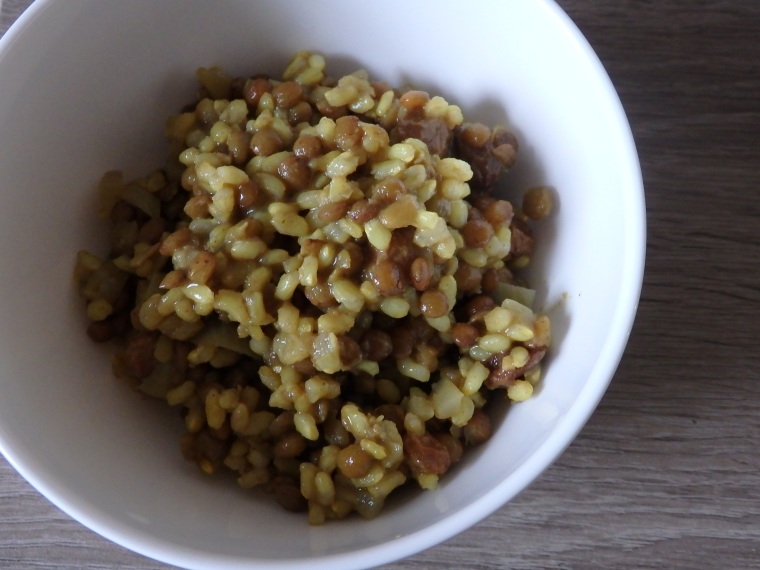
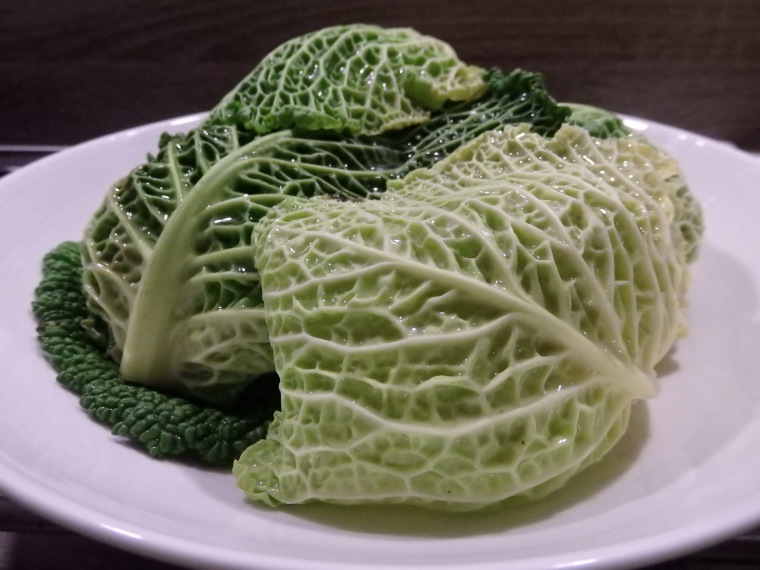
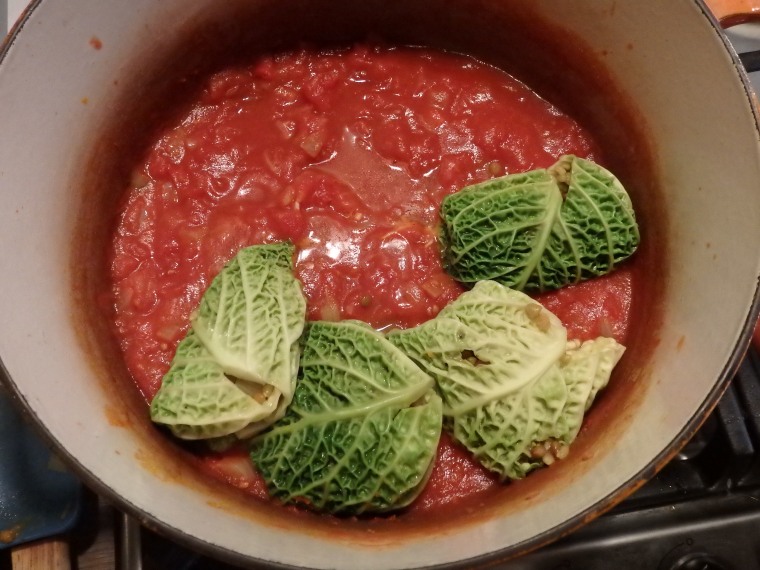
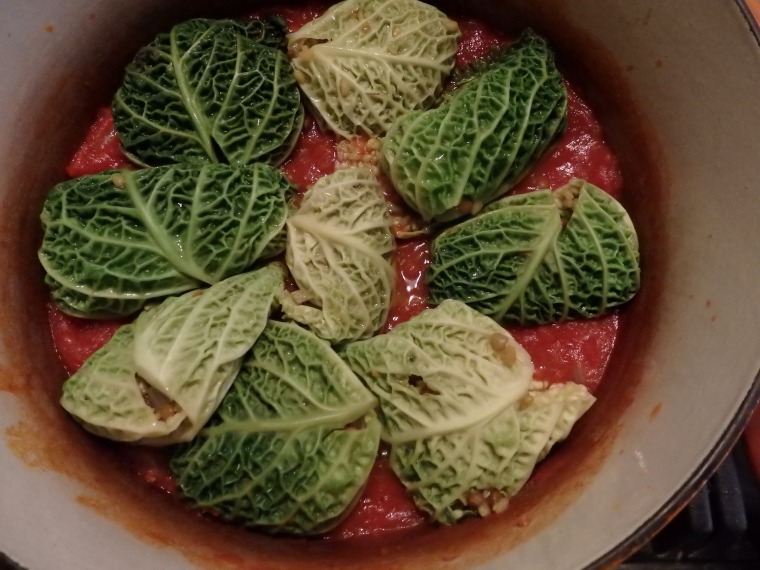
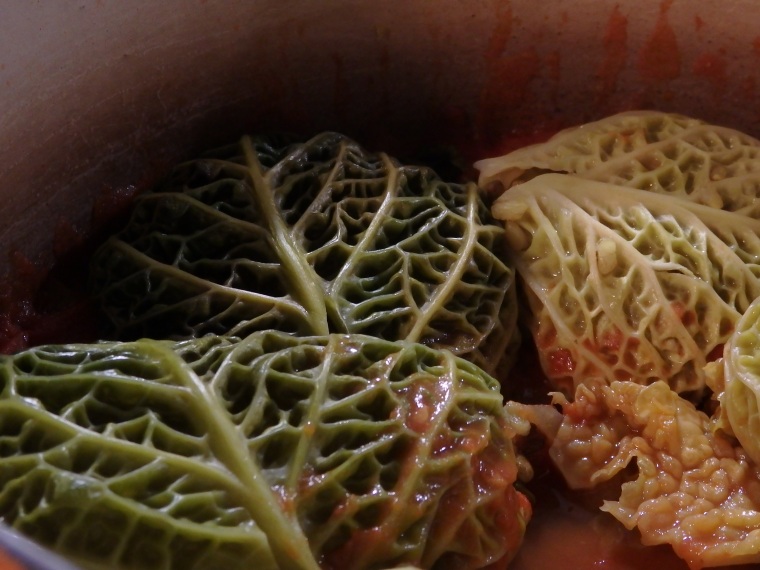
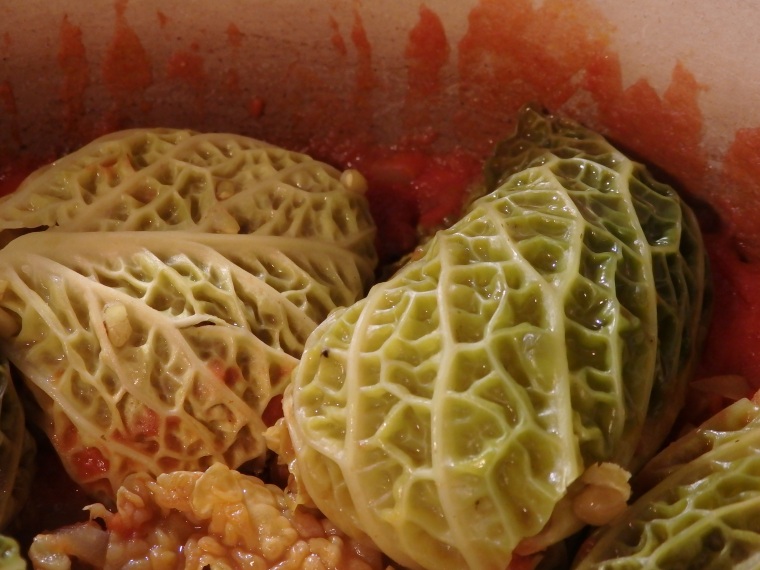
We always have cabbage and often Napa cabbage in the house. Not sure what I’d do without it! It’s good in miso soup too. My favorite is sauté a ton of it with raisins, onions, garlic, sausage and curry powder and apples.
LikeLike
That sounds really tasty – we’ll have to try that with the cabbage we bought yesterday!
LikeLike